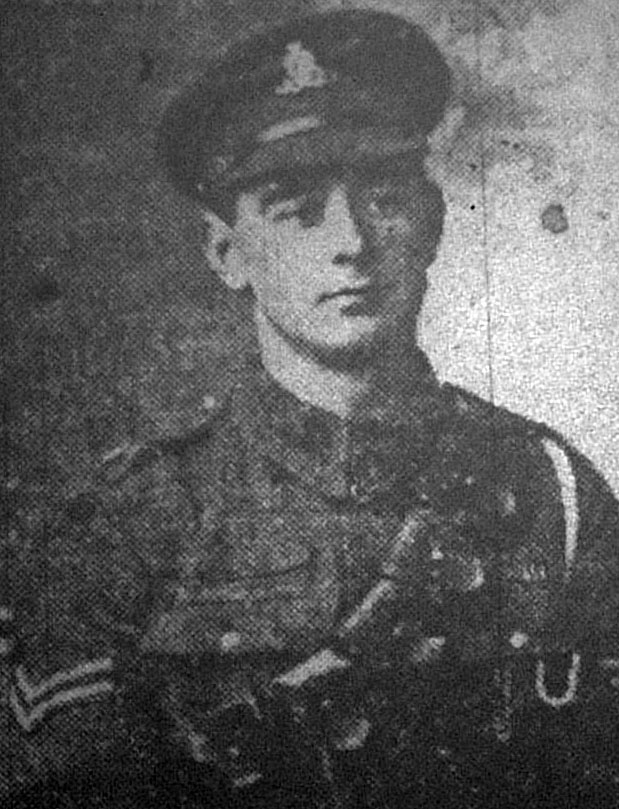
WARD, THOMAS HENRY (Military Medal)

Photograph with kind permission from the Uttoxeter Advertiser
|
|
Source |
||||
|
CWGC |
SDGW |
Uttoxeter Advertiser |
Other |
||
|
Parents |
George and Annie Ward |
Yes |
|
|
2 |
|
Where born |
Uttoxeter |
|
Yes |
|
|
|
When born |
|
|
|
|
|
|
Address |
Forest View, High Wood (Parents and self) |
Yes |
|
1b |
|
|
Forest View, Woodlands Grange, Highwood, near Uttoxeter (Parents) |
|
|
|
2 |
|
|
High Wood, Uttoxeter |
|
|
1b |
|
|
|
Woodland Grange, Highwood (parents) |
|
|
1a |
|
|
|
Spouse |
|
|
|
|
|
|
Children |
|
|
|
|
|
|
Employment Before Joining up |
|
|
|
|
|
|
When joined up |
January 1917 |
|
|
1b |
2 |
|
Where enlisted |
Uttoxeter |
|
Yes |
|
|
|
Regiment |
Royal Field Artillery |
Yes |
Yes |
1b |
2 |
|
Unit |
"A" Bty. 158th Brigade |
Yes |
|
|
2 |
|
Rank |
Corporal |
Yes |
|
1b, 1c |
|
|
Acting Corporal |
|
Yes |
|
|
|
|
Bombardier |
|
|
1a |
2 |
|
|
Service Number |
204400 |
Yes |
Yes |
|
2 |
|
Date of Death |
3 November 1918 |
Yes |
Yes |
|
2 |
|
Age at time of death |
22 |
|
|
1b |
2 |
|
Where Killed or died |
Lille – Petit Rumes |
|
|
|
|
|
France/Flanders |
|
Yes |
|
|
|
|
How he died |
Died of wounds |
|
Yes |
1b |
2 |
|
Location of Grave or Memorial |
Fretin Communal Cemetery - Grave 8 |
Yes |
|
|
|
|
Uttoxeter Town War Memorial (Market Place) |
|
|
|
2 |
|
|
Awards |
Military Medal |
Yes |
|
1b, 1c |
2 |
Thomas joined the forces in January 1917 as a gunner in the Royal Field Artillery[1b].
After a short period of training he was sent to ‘France’, where he saw what the Uttoxeter Advertiser[1b] described as “some very stiff fighting, notably at Passchendaele” and it was here that he was promoted to Lance-Corporal[1b].
He later saw service at Arras, where he obtained the Military Medal for conspicuous gallantry in saving his officer from a burning gun pit[1b].
In February 1918 he wrote to his parents to describe a Y.M.C.A Hut that he had seen and which had connections with home. He was writing his letter in the hut, which was paid for by subscriptions from the ‘good friends of Uttoxeter and District’. Part of his letter was quoted in the Uttoxeter Advertiser[1a]:
“The Hut links up “home” in a very special manner, with large letters denoting the district in which the money was subscribed. It is situated where troops can rest after the struggle, hardship, and danger of the fighting line.”
He came home for 14 days’ leave during September 1918 and had only been back in ‘France’ for six weeks when he was killed[1b, 2].
According to the obituary that was published in the Uttoxeter Advertiser[1b] Thomas died of wounds received during action in November 1918, right at the end of the war.
News of his death was first brought by a letter from the Chaplain of his detachment, who was with him until the end. The Uttoxeter Advertiser[1b] provided details of what he said. He told Thomas’s parents that he was admitted to hospital suffering from severe wounds in the jaw and abdomen, but although they were of a serious nature, Thomas did not realise this and asked the Chaplain to write home saying that he was wounded and not to worry. In spite of all that the nurses could do he died within a few hours of his admission to hospital and was buried in the Cemetery at Fretin near Lille. [1b].
As well as the letter from the Chaplain, the obituary[1b] also spoke of a letter from the matron of the hospital as well as letters from his officers, all of which expressed deep sympathy[1b]. An extract from a letters from an officer under whom he served was quoted as follows[1b]:
“We all miss him very much, for his kindness and unselfishness were always apparent in all his work”.
He was only 22 when he died[1b].
Thomas is buried in Grave 8 in the Fretin Communal Cemetery.
Fretin is a village in the north of France 10 kilometres south-south-east of Lille. The Commonwealth war graves are situated to the right of the entrance towards the middle of the cemetery. They belong to soldiers who died in the 1st Australian Casualty Clearing Station at the end of October and in early November, 1918.